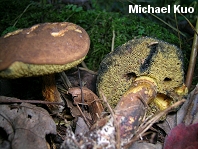| Major Groups > Boletes > Boletus > Boletus pulverulentus |

|
Boletus pulverulentus [ Basidiomycetes > Boletales > Boletaceae > Boletus . . . ] by Michael Kuo I think Boletus pulverulentus should be called the "dirty bolete." While I'm not the most fastidious, cleanly, superego-dominated person I know, something in me wants to give this messy mushroom a bath. Its stem is dirty, it bruises blue everywhere, its cap is unkempt . . . In short, it just needs to get it together and make something of itself. Identifying features include the dark brown cap, the quick blue bruising, the large and angular pores, the raised ridges on the stem, and the fact that the cap surface flashes green when a drop of ammonia is applied. Boletus pulverulentus grows under hardwoods or conifers in eastern North America and in Texas. Collections from the West Coast and the Pacific Northwest may represent Boletus rainisii, which was named in 2000; while similar to Boletus pulverulentus, it bruises green rather than blue, and has a smooth stem. Description: Ecology: Mycorrhizal with hardwoods or conifers; growing alone or scattered; summer and fall; northeastern North America and Texas. Cap: 4-10 cm; convex, becoming broadly convex; dry or moist; finely velvety or dusted when young, but soon smooth; dark brown to blackish brown; bruising bluish black when fresh and young; sometimes becoming cracked in places, with reddish tints in and around the cracks. Pore Surface: Yellow, becoming brownish yellow with age; bruising instantly dark blue; 1-2 angular pores per mm; tubes to 15 mm deep. Stem: 4-8 cm long; 1-2.5 cm thick; more or less equal; solid; bright yellow at the apex; reddish brown to brown below; with raised ridges, though not truly reticulate; bruising blue; basal mycelium white but soon darkening to brown when handled. Flesh: Yellow, staining instantly blue on exposure; red in the base of the stem. Odor and Taste: Not distinctive. Chemical Reactions: Ammonia flashing green, then quickly resolving to black on the cap surface; erasing the blued areas of the flesh. KOH black on the cap surface; orangish on flesh. Iron salts negative on the cap surface; erasing the blued areas of the flesh. Spore Print: Dark olive to olive brown. Microscopic Features: Spores 11-14 x 4.5-6 µ; smooth; subfusoid. Cystidia fusoid-ventricose; abundant; 32-50 x 8-15 µ; with granular, amorphous, reddish brown content when mounted in Melzer's. REFERENCES: Opatowski, 1836. (Singer, 1947; Snell & Dick, 1970; Smith & Thiers, 1971; Thiers, 1975; Smith, Smith & Weber, 1981; Phillips, 1991/2005; Metzler & Metzler, 1992; Both, 1993; Bessette, Roody & Bessette, 2000; Roody, 2003; McNeil, 2006.) Herb. Kuo 09139401, 09220408. This site contains no information about the edibility or toxicity of mushrooms. |
© MushroomExpert.Com |
|
Cite this page as: Kuo, M. (2004, September). Boletus pulverulentus. Retrieved from the MushroomExpert.Com Web site: http://www.mushroomexpert.com/boletus_pulverulentus.html |
